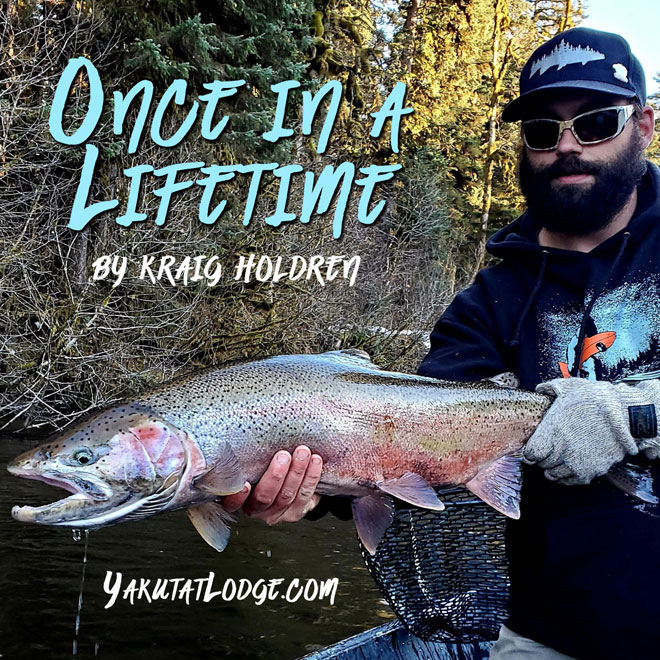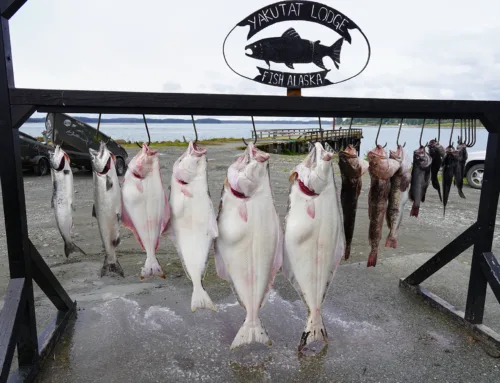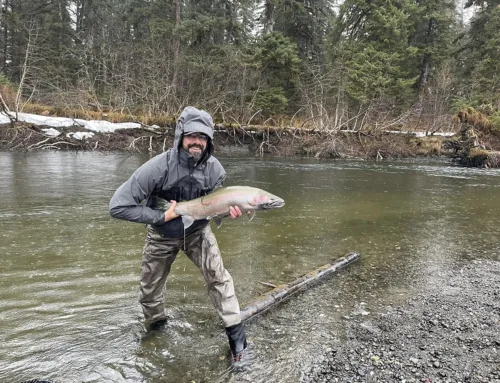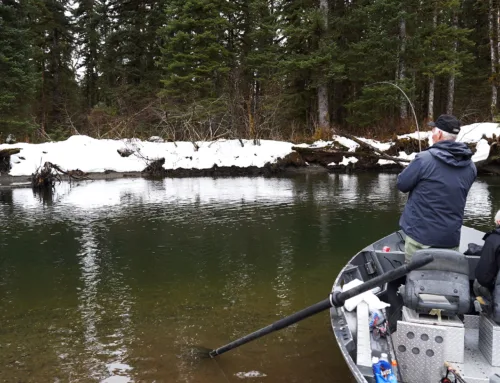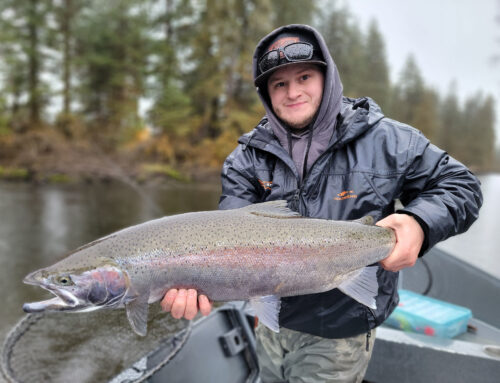Steelhead Fishing Report by Kraig Holdren
The steelhead fishing report for the Situk River has thousands of anglers traveling from all over the world to have an opportunity to get their hand at those numbers. Every guide has wondered what it would be like to have their own steelhead stream to themselves. Don’t get me wrong, as guides we love what we do. We love to teach and share our passions with others, but in reality, we would all rather be just fishing.
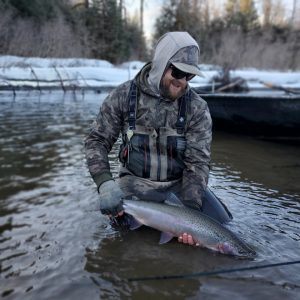
As we all know, the pandemic caused by the coronavirus has affected us all in many different ways. For us in Yakutat it was a hell of a crushing blow. Steelhead fishing on the Situk is world renowned, and anglers from all over the state, country and world visit Yakutat each year to take advantage of its crystal-clear waters and rich run of native steelhead. Due to the fear of spreading the virus the State of Alaska quickly instituted a travel ban which not only affected our out-of-state clients but also our in-state anglers as well. That, coupled with The City of Yakutat’s mandatory quarantine, pretty much made it impossible for anyone anywhere to fish here, except a few local fishermen who made the best of a shitty situation. I wanted to write this article as a way of answering that same question that I think every guide and client has asked: “What would it be like to have the Situk River all to yourself?” Well, let me tell you…It was good.
As a full-time resident of Yakutat, I get to take many liberties that others do not–opportunities that some may never be presented or in which others may not be interested. One of those opportunities is year-round access to the Situk River, however, this year was different.
Yakutat’s winter was a doozy. The past several years the winters have been mild. Maybe a couple weeks a year the roads got snowed in but for the most part I’ve been able to fish almost year-round. Not this year. From about December 15th until the early days of February it snowed…and snowed and snowed some more. There were not accurate counts because of power outages and other bush problems, but I’d say we got between seven and nine feet of snow in about eight weeks. That’s a lot. There were days towards the end when I was buried up past the doors of the plow truck and cursing Mother Nature. However, I was excited about the one thing–lots of snow brings lots of runoff which means perfect water conditions all steelhead season on the Situk.
I typically would travel to the 9-mile bridge about every other day by snow machine to check my trap line and look for fish. On February 14th, I was pulling my line as the snow had overcome my sets and I was tired of post-holing for empty traps. Standing on the bridge I could see that all-too-familiar shadow—a glimpse of a steelhead! I raced home, grabbed a float rod rigged with a peach-colored jig, bungeed it to my sled and raced back to the river.
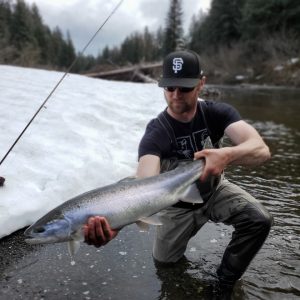
It was 25 degrees out and I was standing in knee-deep snow on top of a berm that is usually a thick rat’s nest of willow and alder. After adjusting my bobber knot, I let fly. The bobber drifted about two feet and disappeared. I was so shocked, I just stood there in wonderment; then up comes the bobber and down goes my self-image. After a few choice words of wisdom to myself and the cow moose on the adjacent bank, who I’m pretty sure was laughing at me for my mistake, I made another cast. The jig hit the water and the float disappeared again! This time I did not hesitate. If it was a lesser fish I think I would have pulled the jig through his skull, I set so hard. Boom! First fish of the season–a nice, chrome hen, nothing of notable size but a damn fine specimen. I didn’t get to fish much over the following 10 days or so due to work (I was getting ready to open the lodge).
Anyone who has fished the Situk has seen the impressive log jams of ancient hemlock, spruce and cottonwood piled high like a giant version of pick-up sticks. This winter being as snow-laden as it was, I decided to get an early start on clearing the river. I talked to a couple of the other local guides and we planned to meet in the middle, me from the top down them from the bottom up. It takes a lot of work to cut holes in the logjams in that river, and this year was no different. At one point I cut over 10 trees in a ½-mile stretch of river, and the mountain of snow and ice buildup on top of them made it more work than usual…about three weeks, actually. During that time, I would cut, then fish my way back up river.
During those three weeks I and a few of the other guys who were helping me out would see a fish here, a fish there, and they were all bitey but none were what I consider “fresh” or “spring” fish. Rather, they were the fall/winter run. It was not until we had cut our way down below the halfway point that we started catching the shiny ones. At this point I still had every intention of opening our doors April 1st and was so excited for our clients to show. The water temperatures were low, the water levels were very, very low as it had not warmed up enough yet for the snow to begin melting, but the fishing…The fishing was productive.
Then along comes Mr. Corona and throws a ratchet in my gearbox. Travel bans and shutdowns forced us to extend our opening to May 1st. We were devastated to have to reach out to our clients and give them the bad news. At that point I and two of our guides who were now stuck in Yakutat had nothing better to do but fish. And fish we did.
The first two weeks were indescribable. We always tell our clients that at the peak of the run the Situk will have about 500 fish per mile. Depending on water conditions, weather and thousands of other guide excuses, some days are incredible and some aren’t. Pressure has a lot to do with that which you can sometimes find on the ADF&G steelhead fishing report. In a clear-water stream like the Situk the fish can see you just as well as you can see them and just like any steelhead, when you catch enough in one spot, they stop biting. With normal pressure on the Situk, you will average one or two hook-ups per mile; on a great day it could be many more. During those first two weeks, it was many, many more. Access to the river was still tough; trail fishing was out of the question due to snow and we were many times bulldogged by moose who were trapped in the river corridor. The poor critters really had nowhere to go, and many were pregnant cows. Due to the moose situation, we really only got to fish small sections at a time, but it didn’t matter. In fact, for the first few days we only fished from the takeout to about a mile above the weir. Some days we would go higher; others not so much.
Weather was still barely getting above freezing and the water levels were painfully low. 12-pound fluorocarbon and 1/8-ounce jigs from Get M Dry or BnR worms were killing it. Doubles, triples and more–it was insane fishing! Make a cast…catch a fish. It was so good on some holes it seemed like it would never end. The fish were aggressive, powerful and plentiful.
One day in particular stands out above the others. We were at a hole called Renny’s. It was early morning, cold, and the weather called for sun all day. Water levels were hovering around 85 or 90 cfs, which looks good on the steelhead fishing report. When we got on the beach, I fired in the first cast. BOOM! Fish on, fish gone. Then three casts and three fish. Then it was seven casts, seven fish and on and on and on. After seven back-to-back doubles, two triples and several more missed opportunities, we had spent two hours in one spot and had chances at over 40 fish and landed 20. I have never been a numbers guy, but that day will be burned into my memory forever and that was just one of the spots we fished that day.
As the days got longer, and the temps warmed up the snow began to melt. The water levels were slowly on the rise and staying there (In fact, it’s May 14th as I am writing this, and the levels have not changed much). The water level reached the mid-300’s which is pretty much as perfect as it gets, and the water temperatures were perfect. Fish began pouring in the Situk, and we were taking advantage of this once-in-a-lifetime opportunity. Some days we fished 1 mile, somedays 10 miles and a couple times the whole 14. Some days were better than others.
As the month dragged on so did the pandemic and we quickly realized that we would not be having a steelhead season here at The Yakutat Lodge. As we hesitantly decided to continue our closure into June, we continued our fish capades.
During the final week of April and first weeks of May we slowed our approach. The steelhead fishing report recorded that the spawn started earlier than I had expected. During a normal season, every day we’d drift over a fish, that fish would run away and hide, then come back out to his chosen spot or redd and continue its business. Then along would come another boat and another and another each time the fish would swim off. Not this year. Undisturbed, I think these fish do their business and go when they have the ability to do so. It is now May 14th and the run has stalled. There are very few fresh fish in the river, and many are actually spawning or have completed spawning and have returned to the ocean to rebuild and repair the damages that spawning causes them. The snow is all but gone here at sea level. The moose have moved back to the shaded meadows and the bears are starting to prowl, hoping for a healthy run of salmon after such a harsh winter. The king salmon fishing is picking up in the bay and we are slowly gearing up to open June 18th in time for our annual sockeye run.
I hope this steelhead fishing report has shed some light on the age-old question of “What if…?”

